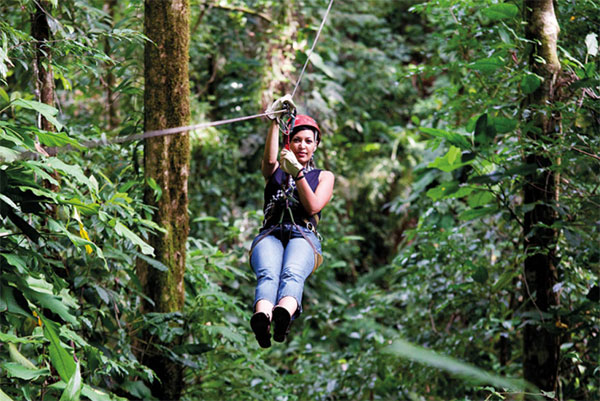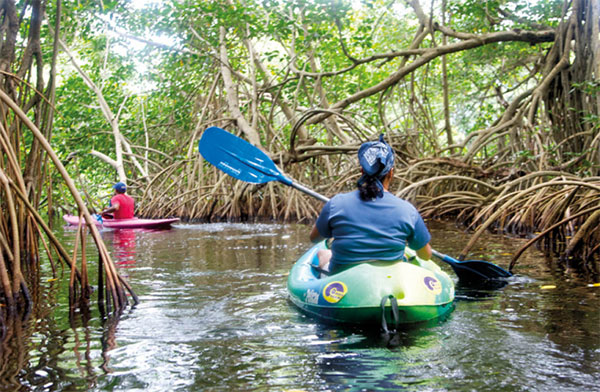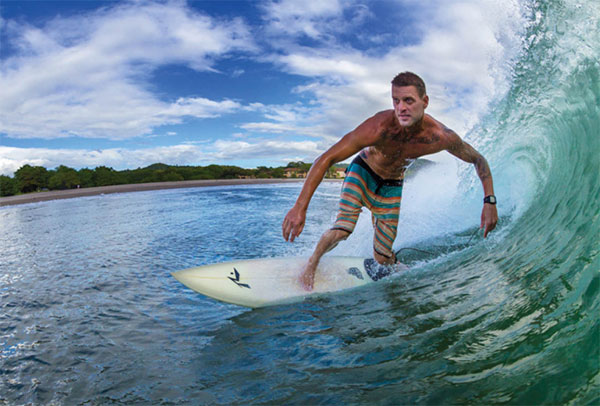Canopy tours
One of the most popular and readily accessible adventure sports is ziplining, also known as a canopy tour. Modern canopy tours were invented in the 1970s, when botanists and ecologists began looking to the mostly unstudied rain and cloud forest canopies and strapping on climbing gear to get close to them. Over time, this transitioned into a tourist activity and ziplines are now found all over the region, from the Rivera Maya and the Bay Islands to the jungles of Panama.

Zip lining in Dominical, Costa Rica.
Corrie Wingate/Apa Publications
The region’s original canopy tour was established in Costa Rica and involved donning a waist harness, climbing inside a huge, hollowed-out matapalo (strangler fig) tree up to a wooden platform, hooking your harness onto a wire cable, then stepping off the platform into thin air, perhaps 30 meters (100ft) off the ground, and whizzing along, suspended from the cable to the next platform in the tree tops. The idea is a refinement of the method used by biologists to get up into the canopy to perform research. Some tours retain that focus on natural history and the chance to get close-up looks at life in the canopy. But most zipline tours today are focused on fun. Taking that first step into thin air is quite a thrill. Cables, harnesses, and safety equipment have to meet high government standards, but you are still at the mercy of human error, so choose a canopy tour operator who talks a lot about safety measures and gives careful, complete instructions to neophytes.
Whitewater rafting and kayaking
Whitewater rafting (also known as river running) and kayaking offer anyone of moderately good fitness an exhilarating way to observe the scenery and wildlife of the country. Dozens of professional outfitters around the region will provide all of the necessities: life preservers, helmets, and rafts or kayaks. You can be assured that you are in good hands: guides have been through training in the classroom and on the rivers. Many head guides have been trained at whitewater schools in the US and have worked with the world’s best.

Kayaking through Cacao Lagoon, Honduras.
Costa Rica has more accessible whitewater rivers and rapids than any other place in the world. It is, of course, the unique geography of the country that makes it one of the world’s great destinations for rafting. To have the right kind of rapids, you need a river that descends in a fairly steep gradient. The four mountain chains that wind down the axis of Costa Rica provide the perfect conditions. The Talamanca range and the Cordillera Central have many steep, wide, perennial rivers that are regularly supplied with bounteous rainfall.
The variety of these rivers provides an enormous range of wilderness experiences. Some offer idyllic float trips through luscious landscapes with abundant wildlife, while others contain explosive whitewater and raging rapids that challenge the most experienced rafter. Primary rafting rivers include the Sarapiquí River, flowing through the lowlands of Heredia; the Reventazón River, with continuous rapids of moderate to high difficulty; the Pacuare, passing through a deep gorge in dense jungle that contains rich flora and wildlife; and the Corobicí, ideal for rafters who are keen bird-watchers.
In Honduras, the Cangrejal River, on the border of Pico Bonito National Park, has Class III-IV rapids in turquoise water, dodging giant boulders as toucans fly overhead. The region’s longest rafting experience is in La Mosquitia, however, where 13-day expeditions run through the remote Río Plátano Biosphere Reserve, giving spectacular views of rare wildlife, glimpses into little-known Indigenous cultures, and looks at mysterious petroglyphs. In Guatemala, the Cahabon River offers one to five-day expeditions through jungle canyons and caves, stopping at the remote Mayan ruins of Quiriguá. From Guatemala City and Antigua, there are easy one-day trips to the Esclavos, Motagua, and Naranjo rivers. There’s also rafting in the highlands of Panama near Boquete, on the Mopan River in Belize, and on the Paz and Lempa rivers in El Salvador.
Windsurfing & Kitesurfing
Since Costa Rica held its first windsurfing contest on Lake Arenal in the early 1990s, the country has been recognized as an outstanding destination for international windsurfers and, nowadays, kitesurfers. With strong trade winds whipping the picturesque lake into a sea of whitewater and waves, it compares favorably with the world’s best windsurfing locations, such as the Columbia River Gorge in Oregon and Maui in the Hawaiian Islands (with the only caveat that the waves are sometimes rather choppy).

A surfer enjoying perfect waves and clear water in Playa Santana, Nicaragua.
Shutterstock
Almost every other day between January and April, consistent winds of around 20 knots whip at the waves along the length of Arenal, creating excellent short-board sailing conditions. For the rest of the season, lighter winds predominate and are ideal for longboard sailing. Lake Arenal is not a suitable place for beginners. Sideshore winds are consistent and blow across the full width of the lake. The water is a comfortable 18 to 21°C (64 to 70°F) all year round.
Elsewhere in the region there are a handful of excellent wind surfing and kitesurfing spots, such as Punta Chame in Central Panama, Bahía Salinas in northwestern Costa Rica, Llopango Lake in El Salvador, and on Roatán in the Bay Islands of Honduras.
Surfing
Central America’s unending beaches are a fixture on the international surfing circuit and attract hordes of surfers from North America, Australia, and Europe. The region is blessed with masses of beaches: there are thousands of kilometers of Caribbean coast and Pacific shores, sculpted with sandy beaches, rocky headlands, offshore reefs, and river mouths close to coastal jungles. There are also a large number of open beaches that are exposed to ocean swells coming from many directions. However, much of the coastline is removed from civilization, so there may be no amenities, food, or emergency services of any kind within many kilometers. A four-wheel-drive vehicle is often essential, especially during the rainy season.